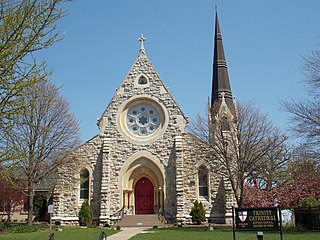
The Cathedral Church of Saint Peter and Saint Paul in the City and Diocese of Washington, commonly known as Washington National Cathedral, is an American cathedral of the Episcopal Church. The cathedral is located in Washington, D.C., the capital of the United States. The structure is of Neo-Gothic design closely modeled on English Gothic style of the late fourteenth century. It is the third-largest church building in the United States, and the fourth-tallest structure in Washington, D.C. The cathedral is the seat of both the Presiding Bishop of the Episcopal Church, Michael Bruce Curry, and the bishop of the Diocese of Washington, Mariann Edgar Budde. Over 270,000 people visit the structure annually.

The Cathedral Church of St. James is an Anglican cathedral in Downtown Toronto, Ontario, Canada. It is the location of the oldest congregation in the city, with the parish being established in 1797. The cathedral, with construction beginning in 1850 and opening for services on June 19, 1853, was one of the largest buildings in the city at that time. It was designed by Frederick William Cumberland and is a prime example of Gothic Revival architecture.

Christ Church Cathedral in Victoria, British Columbia is the cathedral church of the Diocese of British Columbia of the Anglican Church of Canada.

Saint John's Cathedral in Denver, Colorado, United States is the seat of the bishop and the cathedral of the Episcopal Diocese of Colorado and part of the Episcopal Church in the United States. Construction began in 1909, the first service held in the cathedral in 1911, and it was added to the National Register of Historic Places in 1975.

St. Mary's Episcopal Cathedral, designed by Memphis Architect Bayard Snowden Cairns, located near downtown Memphis, Tennessee, is the cathedral church of the Episcopal Diocese of West Tennessee and the former cathedral of the old statewide Episcopal Diocese of Tennessee.

The Episcopal Diocese of Kansas, established in 1859, is the diocese of the Episcopal Church in the United States of America with jurisdiction over eastern Kansas. It is in Province 7 and its cathedral, Grace Cathedral, is in Topeka, as are the diocesan offices.

Trinity Cathedral is an Episcopal cathedral located at 100 West Roosevelt Street in Phoenix, Arizona, in the historic Roosevelt district.

Trinity Episcopal Cathedral, formerly known as Grace Cathedral, is the historic cathedral in the Diocese of Iowa. The cathedral is located on the bluff overlooking Downtown Davenport, Iowa, United States. Completed in 1873, Trinity is one of the oldest cathedrals in the Episcopal Church in the United States. It was individually listed on the National Register of Historic Places in 1974. In 1983 the cathedral was included as a contributing property in the College Square Historic District, which is also listed on the National Register.

The Cathedral Church of St. Paul, is located in downtown Des Moines, Iowa, United States. It is the cathedral church of the Episcopal Diocese of Iowa. The building was listed on the National Register of Historic Places as St. Paul's Episcopal Church.

The Cathedral of Our Lady of Perpetual Help is a Catholic cathedral and parish church located in Rapid City, South Dakota, United States. Completed in 1962, it serves as the third cathedral of the Diocese of Rapid City.

St. John's Episcopal Church is a parish church in the Episcopal Diocese of Iowa. It is located in Keokuk, Iowa, United States. It was listed, together with the parish hall, on the National Register of Historic Places in 1989.

St. Paul's Episcopal Church is a parish church in the Diocese of Iowa. The church is located in Durant, Iowa, United States. The church building and parish hall have been listed on the National Register of Historic Places since 1985.

The Basilica of the Co-Cathedral of the Sacred Heart is a cathedral church and a Minor Basilica located in Charleston, West Virginia, United States. Along with the Cathedral of St. Joseph in Wheeling it is the seat of the Catholic Diocese of Wheeling-Charleston. The parish complex is a contributing property in the Downtown Charleston Historic District on the National Register of Historic Places.

Grace and Holy Trinity Cathedral is an Episcopal cathedral in the Quality Hill neighborhood of downtown Kansas City, Missouri, United States. It is the seat of the Episcopal Diocese of West Missouri.

Christ Cathedral is the cathedral church for the Episcopal Diocese of Western Kansas. It is located in Salina, Kansas, United States, and has been listed on the National Register of Historic Places since 2010.

St. Mark's Pro-Cathedral is an Episcopal Church building located in Hastings, Nebraska, United States. It has been listed on the National Register of Historic Places since 1987.

Trinity Episcopal Cathedral is an historic church building at 310 West 17th Street in Little Rock, Arkansas, United States. It is the seat of the Diocese of Arkansas and is listed on the National Register of Historic Places.

The Cathedral Church of St. Luke is an Episcopal cathedral in Orlando, Florida, United States. It is the seat of the Diocese of Central Florida.

St. Matthew's Cathedral is an Episcopal cathedral located in Laramie, Wyoming, United States. It is the seat of the Diocese of Wyoming. The cathedral is a contributing property in the St. Matthew's Cathedral Close, a historic district listed on the National Register of Historic Places.

The Cathedral Church of St. Peter is an Episcopal cathedral in St. Petersburg, Florida, United States. It is the seat of the Diocese of Southwest Florida. It 2004 it was included as a contributing property in the Downtown St. Petersburg Historic District on the National Register of Historic Places.





















